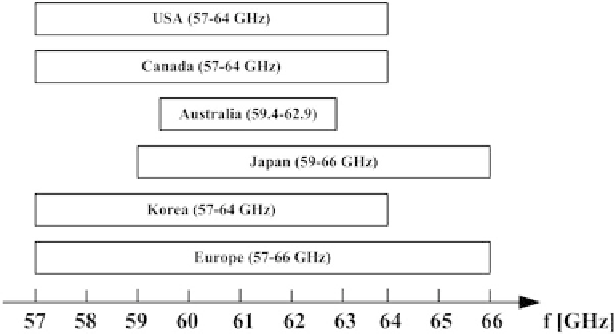Biomedical Engineering Reference
In-Depth Information
Fig. 1
Worldwide allocations of 60-GHz unlicensed bands
SoC radio transceivers enabling wireless body-centric communications. In detail, it
focuses on the feasibility of SoC transceivers in nano-scale complementary metal ox-
ide semiconductor (CMOS) technology. Section 1 reports an introduction to 60-GHz
band and its applications. Section 2 introduces wireless body-centric communica-
tions, technology challenges, and opportunities. Section 3 reports a preliminary
feasibility study of SoC transceivers by taking into account the main characteristics
of the radio channel and the main limitations of the nano-scale CMOS technology.
The co-integration with wearable millimeter-wave antennas for on- and off-body
communications (integration with textile, miniaturized flexible antennas, etc.) will
be considered as well. Finally, the conclusions are drawn in Section 4.
Introduction
In 2001, the Federal Communications Commission (FCC) allocated an unlicensed
7-GHz wide band in the radio-frequency (RF) spectrum from 57 to 64 GHz for
wireless communications [
1
]. This is the widest portion of RF spectrum ever allocated
in an exclusive way for wireless unlicensed applications, allowing multi-gigabit-
per-second wireless communications. Other countries worldwide have allocated the
60-GHz band for unlicensed wireless communications [
2
-
5
], allowing in principle
a universal compatibility for the systems operating in that band. Figure
1
shows the
60-GHz frequency band allocations in USA, Canada, Japan, Australia, Korea, and
Europe.
The 60-GHz band is very attractive for its reduced coverage range, which is limited
to a few meters as a result of the dramatic attenuation of the signal propagation.
This is primarily due to the high path loss at 60 GHz. This reduced coverage range
allows several wireless personal area networks (WPANs) to operate closely with low
interference.

Search WWH ::

Custom Search